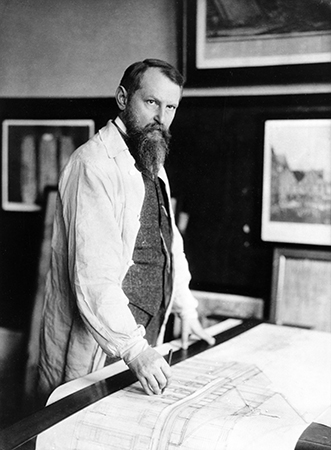Subscriber Benefit
As a subscriber you can listen to articles at work, in the car, or while you work out. Subscribe Now
Deeply imbued with the knowledge that great figures of the past inspire the present and shape the future, Indianapolis takes history seriously. With the exception of Washington, D.C., Indy has more historic monuments and memorials than any other U.S. city. Often referred to as the Circle City, at the center of Monument Circle stands its most recognizable sight, the Soldiers and Sailors Monument.
![]() The monument was designed by German architect Bruno Schmitz, who also drew up the plans for the largest three war monuments in Germany. Born in Dusseldorf in 1858, Schmitz studied architecture there before setting up his practice in Berlin, where he began lecturing at the Berlin Academy. In 1888, his commission for the Soldiers and Sailors Monument secured his reputation as a monument designer.
The monument was designed by German architect Bruno Schmitz, who also drew up the plans for the largest three war monuments in Germany. Born in Dusseldorf in 1858, Schmitz studied architecture there before setting up his practice in Berlin, where he began lecturing at the Berlin Academy. In 1888, his commission for the Soldiers and Sailors Monument secured his reputation as a monument designer.
The monument would occupy the circle at the intersection of Meridian and Market streets, which city designer Alexander Ralston called Governor’s Circle, intending it to be the site of the governor’s mansion. A residence was built there in 1827, but it was surrounded by a public thoroughfare and no governor ever occupied it. The building was torn down in 1857, and the site was later renamed Circle Park.
Proposals to build a Civil War memorial were made as early as 1862, before the war’s conclusion. Then, a Civil War veterans’ reunion in Indianapolis led to the formation of a commission, which first met in 1887. A sum of $200,000 was set aside for the project, Circle Park was designated as its site, and an international competition to design the monument was announced.
Celebrating the contributions of Indiana’s soldiers to the Civil War made sense. Nearly three-quarters of all Indiana residents capable of bearing arms had served in the Union cause, a higher fraction than any state except Delaware. Early in 1888, the 29-year-old Schmitz’s design, titled “Symbol of Indiana,” was declared the unanimous choice of the commissioners.
Schmitz arrived here in 1889. When the cornerstone was laid, it contained a copper box bearing a list of the Hoosier soldiers who had served in the war, a 38-star American flag, and a photograph of Schmitz. The monument was planned to be the nation’s third largest, behind only the Washington Monument and the Statue of Liberty.
Construction took 13 years, during which additional appropriations were necessary, bringing the cost of the project to just shy of $600,000. It has been estimated that completing the project today might top $500 million. The monument was dedicated on May 15, 1902, with Hoosier “Ben-Hur” author Gen. Lew Wallace presiding.
The monument is a 284.5-foot-tall obelisk, with an exterior featuring limestone from Owen County. Atop is the bronze figure of Victory, melding features of a Greek goddess and an American vision of liberty. At the base are limestone tablets bearing the names of Indiana soldiers with the inscription, “To Indiana’s Silent Victors.”
Numerous sculptures on the monument were created by Rudolph Schwarz. These include the two groupings, “War” and “Peace,” as well as two smaller scenes, “The Dying Soldier” and “The Return Home.” Schwarz arrived in Indianapolis in 1897 and remained here until his death in 1912. At that point he had contributed more than 30 sculptures throughout the state.
The monument’s interior includes a 331-step staircase and an elevator leading to an observation deck, although elevator riders must ascend 31 more steps. In 1916, a Civil War museum opened at the base, named for Col. Eli Lilly, Eli Lilly and Co.’s founder.
Since 1962, the monument has been annually adorned with nearly 5,000 lights and billed as “the world’s largest Christmas tree.” In 1973, it was added to the National Register of Historic Places. Today, the flag of Indianapolis features Monument Circle, with a star representing the monument itself at its center. Schmitz, who died in 1916, would have been proud.•
__________
Gunderman is chancellor’s professor at Indiana University.
Please enable JavaScript to view this content.
